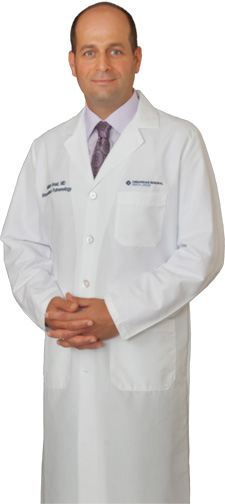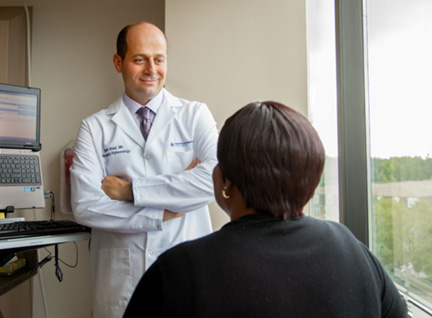Chesapeake Regional Healthcare Interventional Pulmonology Bayview Physicians, Pulmonary Medicine of Virginia Beach
 Had it not been for the fact that English medical textbooks cost less than French ones, Dr. Melhem Imad might be practicing pulmonary medicine today in France rather than the United States. Growing up in the small town of Batroun in Lebanon, he had studied both French and English, so those savings ultimately – if indirectly – resulted in him coming to America.
Had it not been for the fact that English medical textbooks cost less than French ones, Dr. Melhem Imad might be practicing pulmonary medicine today in France rather than the United States. Growing up in the small town of Batroun in Lebanon, he had studied both French and English, so those savings ultimately – if indirectly – resulted in him coming to America.
He’d always known he’d eventually leave Lebanon: “We’ve always traveled,” he says. “It’s a common thing. There are more Lebanese outside of Lebanon than in the country. You either go to Europe or to the United States.” After graduating from the Lebanese University of Medical Sciences in Hadath, he did a rotating internship at the Lebanese University in Beirut. And in 2001, he began an internship and residency in internal medicine at New York’s Staten Island University Hospital, where he pursued a medical pathway rather than surgical. “I preferred the mystery and the problem-solving aspect of diagnosing and caring for patients,” he says. “I liked the intensity of internal medicine.”
He was particularly interested in pulmonary medicine, and especially the relatively new field of interventional pulmonology. His research led him to apply for and receive a three-year fellowship for pulmonary and critical care at the University of Texas Medical Branch in Galveston.
He enjoyed the curriculum at the University of Texas, but there were newer procedures in interventional pulmonology that weren’t being taught there. He spent a good deal of energy “jumping through hoops,” he says, convincing his program to let him train on elective rotations at some of the institutions that were teaching those procedures. His persistence was rewarded: he completed a four-week rotation in interventional pulmonology at the Cleveland Clinic and six-weeks at the University of Pennsylvania.
By then, he had spent half of his six-year visa getting training, so he went to work, began the process of naturalization, and came to Hampton Roads to join Pulmonary Medicine of Virginia Beach. “I wanted to be on the East Coast,” he says, “because it’s closer to Europe and to Lebanon. And since I’ve always lived near the beach, I wanted that environment as well. Hampton Roads was a perfect location.”
He brought with him innovative new technology and procedures. “We started doing endobronchial ultrasound, which is now a very common procedure in the hospitals,” he says, “but in 2007, no one was doing it. EBUS allows us to stage lung cancer and inflammatory diseases affecting the lungs, and lets us biopsy lymph nodes, without having to do surgery, through transbronchial needle aspiration.”
Still, Dr. Imad felt his training was incomplete, and when he learned about a fellowship opportunity at Johns Hopkins in interventional pulmonology, he applied. He was recommended by his former colleagues at the University of Pennsylvania, and was accepted. “After three years in private practice, it meant going back into training for a full year,” he remembers. “It meant a change of lifestyle, and a change of finances.” But for a physician dedicated to perfecting his knowledge of his chosen field, it was an opportunity he couldn’t refuse.
 He returned to full-time employment with Pulmonary Medicine of Virginia Beach, and sees patients as an Interventional Pulmonologist at Chesapeake Regional Healthcare. He has also added the Directorships of Interventional Pulmonology and the Respiratory Department at Sentara Virginia Beach General Hospital to his resume.
He returned to full-time employment with Pulmonary Medicine of Virginia Beach, and sees patients as an Interventional Pulmonologist at Chesapeake Regional Healthcare. He has also added the Directorships of Interventional Pulmonology and the Respiratory Department at Sentara Virginia Beach General Hospital to his resume.
“Most of the work we’re doing is with lung cancer patients,” he says. “There’s been more research, especially in the area of genetic testing for lung cancer.” Recently, he explains, it’s been possible to look deeper into the genetics of tumors themselves, and the receptors on the tumors. “Certain genes that make certain tumors are susceptible to certain drugs as opposed to others. The differences in the genetics of those tumors made researchers more interested in trying to target those differences and develop drugs to target only those receptors. So lung cancer is no longer just lung cancer; it’s no longer small cell or non-small cell. It’s allowing us to give more correct treatments with fewer side effects.”
But, he cautions, “We’re far from perfect. And lung cancer is still the number one killer – more than breast, colon, and everything else.” Recently, approval was granted from the Cancer Institute to look for early lung cancer in people who smoked a certain amount for a certain number of years, so “we can do a yearly CT scan to look for early lung cancer while we can potentially cure it. Interventional pulmonology is responsible for advances in endoscopic procedures and other less invasive procedures to treat problems that lung cancer can cause, like putting in stents and doing laser and burning tumors inside the airway so people can breathe better.”
In addition, Dr. Imad has performed procedures that can help emphysema patients breathe more easily by putting certain types of valves in their airways, or by deflating hyperinflated lungs. “Some of these have been on the horizon for a while and are being studied,” he says, “but they’re still not approved by the FDA. We’re hoping that approval comes soon.”
Dr. Imad is an unrelenting advocate of smoking cessation. “We’re fighting lung cancer far better than we did years ago,” he says, “but I still see it every day. I diagnose it at least twice a week. I try to give these patients hope when I can, because there’s so much more now that we can do. But I’ll never stop trying to get people to quit smoking.”

